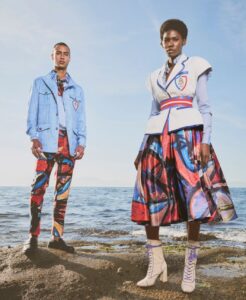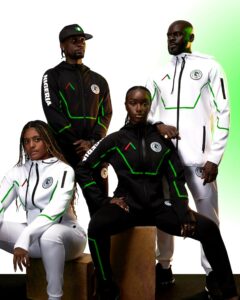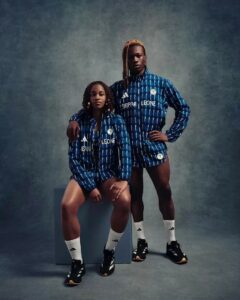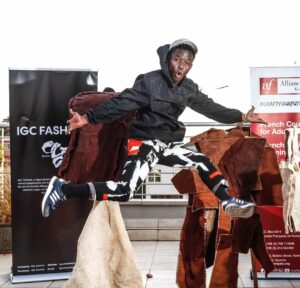It surely can come as no great secret that the Olympic Games provide a wealth of opportunities for the brave and bold. With the XXXIII OLYMPIAD taking place in Paris, fashion too had its place in the equation as the “beautiful” element. Thanks to the increasing number of powerhouse fashion names getting involved in one way or another, it is a foregone conclusion that more than just gold in the various sporting disciplines was up for grabs in world capital of fashion.
For decades global brands such as Nike, Adidas, Fila, Puma, Converse, Reebok, Under Armour, Speedo, Asics, etc. made sure that their names are heavily associated to the Olympics. Each time an athlete wins gold, their brand shares in the glory.
Top fashion brands with a global reach such as Ralph Lauren, Tommy Hilfiger and even Vera Wang – to some degree – have been very active designing Team USA uniforms, and accessories (or attire for specific athletes as is the case of Wang). Today Berluti, Dolce & Gabbana, Ben Sherman, Lululemon, Emporio Armani, Kenzo, amongst others have also sealed deals for designing under the Olympics banner. But they are no longer alone in seeking to expand the prestige of their names and the reach of their brands through the opportunities that come along with Olympic collaborations. Cue the new generation of independent designers…!
A slew of dynamic, minority-created fashion brands took their shot at Olympic opportunities. They designed ceremonial attire, uniforms, Olympic kits, accessories, and specific competition attire. Among them were Stella Jean, LABRUM, Actively Black and IGC Fashion. Together, their work made sure that the last edition of the Games was not only a sporting event, but also a place for cultural expression.
“Designers and manufacturers now realize this can be a huge platform for them, for many things,” commented Alison Brown in a recent article at APNews.com. She was co-host of “Keep the Flame Alive”, a podcast on everything you needed to know about the Olympics.

Stella Jean, a prominent Italian-Haitian designer, created the very stylish opening ceremony looks for team Haiti. She was chosen to dress the fifteen-member women’s and men’s team at the parade of nations during the events’ opening ceremony on the Seine River in Paris.
Jean’s creations for Team Haiti reflected the artisanship and colorful flair that has defined her work and made her brand a favorite in high-profile magazines over the years. They are also imbued with a cultural sensitivity that honors the Haitian people.
Very sensitive to the political and climatic challenges of Haiti, the Rome, Italy-based designer commented, “For these athletes, it’s a victory just to be here… They are 15 living symbols of rebirth and renewal that extend beyond what is usually shown.”
Stella Jean’s creations for Team Haiti also featured Haitian weaving techniques. In addition, painter Philippe Dodard’s “Passage” artwork figured prominently on the fabrics. In unison, the efforts combined into a celebration of the small island nation’s indomitable vitality and dogmatic sensibilities. The women’s looks included a sleeveless blazer created in recycled materials and a full skirt embellished with Dodard’s artworks. It was paired with a chambray shirt woven in Haiti’s traditionof spinning “blue cotton”. The men’s attire featured smart trousers decorated in Dodard’s work. Paired with a jacket, the look was completed with a Guayabera-inspired, striped shirt and printed scarf.

Los Angeles -based athleisure brand Actively Black created the Olympic kit for Team Nigeria. Lanny Smith, the former NBA player for the Sacramento Kings, created the brand to challenge the dominance of companies who profit from “the culture” without truly investing in the culture. Actively Black is an all-inclusive brand that welcomes all who support their mission. They offer athleisure wear, luxury swimwear and bags.

London-based LABRUM by Foday Dumbuya shone through its fruitful collaboration with Adidas. The independent brand partnered with the athletics giant to create Sierra Leone’s Olympic kit. The collaboration yielded looks in attractive colors that move with ease and alacrity from the Olympics Games to the streets. They combined blue and white patterns with a reimagined cowrie shell, which throughout African history has represented wealth and prestige.

Finally, IGC of Uganda made history this year along with the Olympic Games. Known for its creative upcycling approach to fashion, the brand designed the looks for the Ugandan breakdance team. This edition of the Olympics saw the first-ever gold medal awarded in the new breakdancing category and Uganda’s break-dancers brought strong attention to the upcycling fashion actor.
Now the dust has settled upon the Olympics it is clear that these brands achieved a greater level of notoriety. In the past, the honor of creating looks for Olympic teams had generally gone to the deep-pocketed giants of the sports world, or again to prestigious luxury apparel makers like Ralph Lauren and now Kenzo. They had always managed to capitalize on their own participation through widespread television coverage, mentions in the media and broader general appeal.
Some asked, “Can the success of major actors be repeated by these small brands, only if to a lesser degree?”
David Allemann, co-CEO at the Swiss footwear maker ON, which played a role too, seems to believe so. In an interview with Footwearnews.com, he stated, “We feel the Olympics is a great window to bring product innovation to the market. And so, it’s more like a story that we can use to tell.”
Through their own innovation these small brands gained global recognition and now we will see if expansion and entry into new markets, post-closing ceremonies, will bring the rewards that has in the past eluded many deserving minority businesses.
- Photo Courtesy of Stella Jean
- Photo Courtesy of IGC
- Photo Courtesy of Actively Black
- Photo Courtesy of Labrum

